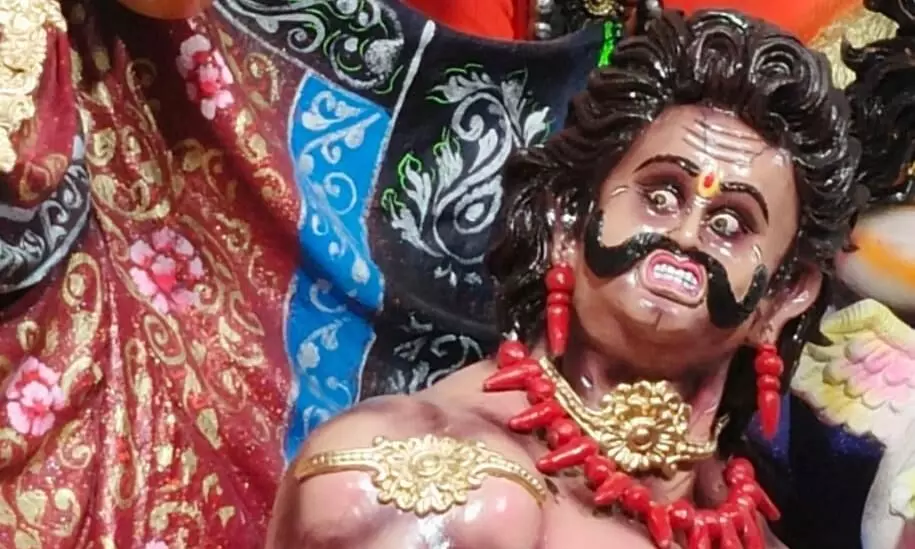
Photo: Twitter
Guwahati: Mysuru, one of the most popular tourist destinations in Karnataka, is known for its enchanting royal palaces and beautifully decorated temples. There are many theories that have evolved on the origin of the name of the city in the glorious history of the place, which was later anglicised to Mysore during the British Raj. Nevertheless, the most enduring theory on the name of the city is told to be derived from the mythological character Mahishasura.
The name- Mysuru, is believed to be originated from 'Mahisha ooru' which in local Kannada means Mahisha's land or Mahisha's city. According to a legend Mahishasura's father Rambha, who was the king of the Asuras, the traditional enemies of the Devas once felt in love with a water buffalo, which in reality was a cursed princess named Shyamala. The son born out of the unorthodox union of Rambha and buffalo was known as Mahishasura. In Sanskrit Mahisha means 'buffalo' and 'Asura' stands for demon and he was named so since he could take the form of either a man or a buffalo at his own wish. Some residents of the city do not even hesitate to declare Mahishasura as a demon with good qualities. According to them, like good and bad human beings, there were good and bad demons in Puranas and Mahishasura was considered one of the good demons
With enormous power and being blessed with the boon from Lord Brahma that no man can kill him, Mahishasura was terrorising the Devas (Demigods). They pleaded to the Trimurti-Brahma, Vishnu and Shiva to get rid of Mahishasura. The Trimurti with divine power created Devi Durga, who destroyed all of Mahishasura's evil minions and finally cut off the head of Mahishasura in the epic battle that continued for nine days and nights with much gore and destruction.
According to another section of people, the name of the city may be originated from Mahishasura Mardini, which means 'Slayer of the Buffalo Demon'. The Goddess Chamundeshwari killed the buffalo demon Mahishasura after he was apparently frightening the natives. The people of Mysuru believe that the Devi slew the demon at the top of the only hillock of the city called Chamundi Hills. The locals believe that after killing the demon, the goddess Chamundi resided on the hilltop, where she has been worshipped with utmost devotion by the city dwellers for ages. Many also suggest that the word Mysuru is a blend of two Kannada words 'My' and 'Suru', where the word My means 'our' and Suru stands for 'shelter', together it means 'our shelter'
While climbing 1,000 steps to the top of Chamundi Hill of Mysuru, one can see not only the temple of Chamundeshwari but also a huge statue of Mahishasura with a snake in one hand and a dagger in the other. Every year, people celebrate Navratri and Mysuru Dasara to commemorate the Puranic past of the city.
Prof. M S Sapna, faculty in the Department of Journalism and Mass Communication, University of Mysore, says "The residents of the Mysuru are the keen devotees of Maa Chamundi. They believe that mother Chamundeshwari, who resides in the Chamundi Bette (hills) of the city, save the residents from all evils. The residents have ardent faith in the religious scriptures and strongly feel that Maa killed the Mahishasura in this ancient city".
The earliest mention of Mysuru in history, away from Puranic tales, may be traced to 245 B.C from the inscription of Ashoka's time. The inscription suggested that at the conclusion of the third Buddhist convocation, a team was dispatched to Mahisha Mandala for the propagation of Buddhism. Some suggest the word Mahisha is probably originated from the name of a disciple of Buddha who arrived in the region to spread Buddhism.
According to another story, Mahishasura was a popular Buddhist king who had great respect for human values, but some people were jealous of his popularity. They conspired and projected him as a demon. Even, he was claimed to have been killed by Chamundeshwari, a fictitious character created by them. Some historians claim that there is a reference in the Pali language that he was the king of Mahisha Mandala. The name of the city of Mysuru is believed to be originated from him as suggested by some scholars.
According to B Sheikh Ali, a noted historian from Mysuru, the name of the city has been originated from the mythological demon character called Mahishasura, who was killed by Chamundeshwari. He has also the opinion that the Muslim ruler Tipu Sultan of Mysore wanted to name the region Manzarabad. However, his plan did not get materialised as he died fighting against the British force and Mysore was handed over to Maharaja, who named the city as Mysore.
P V Nanjaraj Urs, another historian, suggested that there may be many theories on the name of Mysore or Mysuru, but the most popular one is associated with the legend of Mahishasura and Chamundeshwari. He has also the opinion that the region used to be called Yemme Nadu or buffalo land, which later became Mahisha Nadu since Mahisha also means buffalo.
Whether, the religious and palace city of Mysuru is named after the demon king Mahishasura or the Devi Chamundeshwari, or the Buddhist king of Mahisha Mandala or the disciple of Buddha with the name Mahisha who arrived in the city to propagate Buddhism, the people of the cultural capital of Karnataka do not seem to be interested to involve in any controversy, rather happy to live with the legacy of the city that traces its origin from the Puranic times. They feel proud of the name Mysore or Mysuru as given by the Wadiyar dynasty.
About the author
The author is currently working as Associate Professor in the Department of Media and Communication, Central University of Tamil Nadu, Thiruvarur. Readers can reach him at [email protected]
